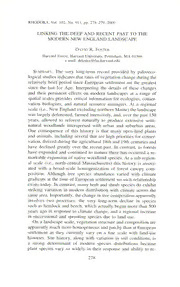
Linking the deep and recent past to the modern New England landscape PDF
Preview Linking the deep and recent past to the modern New England landscape
RHODORA, Vol. 102, No. 911, 278-279, 2000 pp. AND LINKING THE DEEP RECENT PAST TO THE MODERN NEW ENGLAND LANDSCAPE David Foster R. MA Harvard Forest, Hai'vard University, Petersham, 01366 e-mail: drfoster@ harvard. fas. edii Summary. The very long-term record provided by paleoeco- logical studies indicates that rates of vegetation change during the relatively brief period since European settlement are the greatest Age. since the last Ice Interpreting the details of these changes and on modern their persistent effects landscapes range of a at spatial scales provides critical information for ecologists, conser- vation biologists, and natural resource managers. At a regional New scale England excluding northern Maine) the landscape (i.e.. was farmed largely deforested, intensively, and, over the past 150 allowed years, to reforest naturally to produce extensive semi- woodlands natural interspersed with urban and suburban areas. One consequence many of this history that open-land plants is and animals, including several that are high priorities for conser- vation, thrived during the agricultural 18th and 19th centuries and have declined greatly over the recent past. In contrast, as forests have expanded and continued mature to there has occurred a re- markable expansion of native woodland species. At a sub-region- scale north-central Massachusetts) al (i.e., this history associ- is ated with a broad-scale hotiiogenization of canopy com- forest Although abundance position. tree species varied with climate gradients at the time of European settlement no such relationship many exists today. In contrast, herb and shrub species do exhibit modern striking variation in distribution with climate across the same area. Importantly, the change in tree composition apparently two involves processes: very long-term the decline species in such as hemlock and beech, which actually began more than 500 ago years in response to climate change, and a regional increase in successional and sprouting species due land to use. On a landscape scale, vegetation structure and composition are much more homogeneous apparently and patchy than European at settlement as they currently vary on a fine scale with land-use histories. Site history, along with variation conditions, in soil is a strong determinant of modern species distributions because plant species vary so widely response and in their ability to re- 278 — New The England Landscape 279 Foster 2000] cover and example, re-establish for forest cutting, graz- after, fire, ing, or plowing. Stand-level pollen records suggest that the can- opy composition of most was completely changed by forests this and resemblance on same history bears to earlier forests the little and O'Keefe (Foster 2000). sites New Recognition that England a cultural landscape shaped is human in most details by history of intensive activity an its is modem background understanding ecological pro- essential for cesses. Interpretation of the details of this history at geographical and temporal scales relevant to specific concerns can afford tre- mendous management insights into land and conservation policy (Foster 1999). LITERATURE CITED Foster, D. R. 1999. Thoreau's Country: Journey through a Transformed MA. Landscape. Harvard Univ. Press, Cambridge, New AND O'Keefe. 2000. England Forests through Time: Insights J. from the Harvard Forest Dioramas. Harvard Univ. Press, Cambridge, MA,
